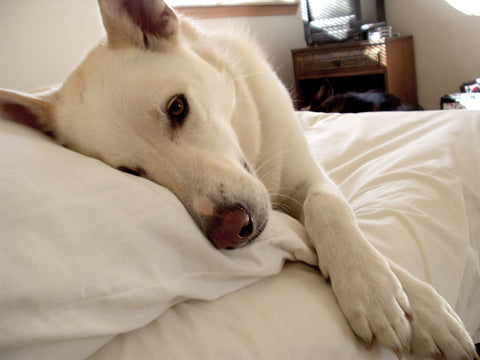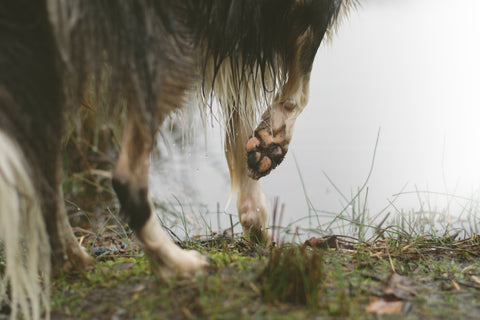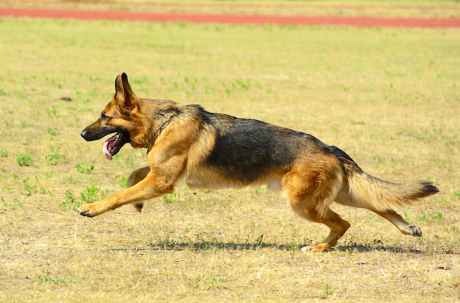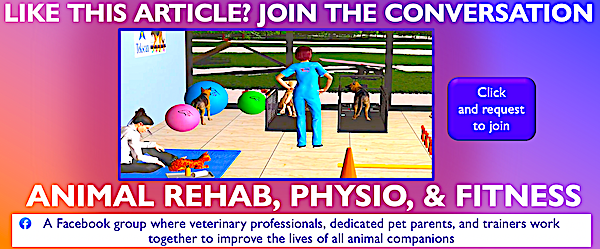The challenge in treating soft tissue injuries is not in the actual treatment itself, but the diagnosis of the soft tissue injury. Once the soft tissue injury is diagnosed and determined, a proper course of treatment may be pursued.
Soft tissue injuries are difficult to diagnose and often require time and patience in determining the specific diagnosis. A thorough history, a deliberate physical examination, diagnostics such as MRI, ultrasound and arthroscopy, palpation and time are often required in the diagnosis of a soft tissue injury. Often differential diagnoses are ruled out before a determination and exact tissue may be determined. Many soft tissue injuries mimic orthopedic problems such as cruciate disease, elbow dysplasia, osteochondritis dissecans, and others. Radiographs and other diagnostics may rule out these problems.
Once the diagnosis is determined, the treatment phase may be initiated. Soft tissue injuries may be located anywhere in the dog’s body, but are very common in the forelimb and hindlimb. The isolation of the soft tissue problem needs to be made and any secondary or tertiary problems need to be identified. For example, many iliopsoas injuries are accompanied by soft tissue and spinal issues with the origin of the iliacus muscle, L2 through L7. Bicipital tendonitis may cause adaptations in the elbow and/or cervical and thoracic region due to the decreased shoulder extension while advancing the body. Therefore, a thorough evaluation and functional assessment is the second step in the treatment of soft tissue injuries. The functional assessment should include the current function and limitation of the dog. The goals of the dog should be established and it should be determined if these goals are reasonable and within what time frame. For example, is it feasible for a dog with a severed strained iliopsoas to return to competitive agility? It may be or it may not be, depending upon the dogs’ condition, weight, proposed program, owners’ ability, access to rehabilitation, and financial considerations.

The evaluation should include information about the dogs’ weight, activity level, chemistry profile, and capability of the owner. Soft tissue rehabilitation always requires compliance with the owner and the necessity for compliancy needs to be established initially. The treatment of soft tissue injuries may be lengthy and this needs to be discussed with the owners at the time of the initial evaluation. It is always a frank discussion that should be held immediately.
After the establishment of the dogs’ problems, goals, and discussion with the owner regarding a realistic plan, the treatment plan may be established. Acute cases of soft tissue cases must be managed with a multimodal approach.
- Non steroidal anti-inflammatory, pain medication and in some cases, muscle relaxants are required to assist with the rehabilitation.
- Rehabilitation modalities, such as laser therapy and cyrotherapy, will be paramount to reduce the pain and inflammation associated with the soft tissue dysfunction. Both are essential in the treatment of the soft tissue problems.
- Laser will aid in the reduction of inflammation, pain, and the promotion of soft tissue healing.
- Cyrotherapy will also reduce the pain and inflammation (ref) and is easily applied by both the clinician and the owner. Cyrotherapy may be applied in the form of ice packs, compression pumps, or ice cups for ice massage. In small areas, the ice cups work well to reduce the inflammation in the area.
The treatment in the acute phase should involve conservative management through both pharmaceutical measures and rehabilitation. The goal is to promote healing and decrease the chances of adhesion formation. A multimodal approach will assist with this goal.
Conservative management of the dog needs to be administered immediately. The owner must be made aware the dog needs to be restricted and maintained in a crate or ex-pen, and be leash walked only. I always emphasize the leash should be a regular leash and not a flexi-lead. Restrictions and owner compliance are realistically one of the more difficult aspects of treating soft tissue injuries because they are beyond our control. The importance of owner education and instruction during the initial evaluation is invaluable.
Deep friction massage or cross friction massage has been utilized in human soft tissue injuries extensively and was developed in an empirical way by James Cyriax, a British physician. The purpose of cross friction massage is to maintain the mobility of the involved soft tissue structure and prevent adhesions from forming. The principal is fairly simple – when there is an inflammation in the soft tissue, there is a disruption of the direction of the fibers. Normally, all of the fibers of the muscle and tendon lie in parallel with each other. When inflammation exists, the fibers lie in disarray and proper functioning of the soft tissue will not exist unless they are realigned. The application of a sweeping manual force perpendicular to the fibers will assist in the realignment of the fibers. This motion is applied to the tendon or muscle and the soft tissue slack of the skin must be overcome. The sweeping motion is applied for a total of five minutes in acute phases. The goals of this treatment are to provide movement to tissue itself and produce traumatic hyperemia and to provide blood supply to the area.

Range of motion may be performed in the initial phases of a soft tissue injury, but stretching should not be performed. Stretching may produce micro tears in the soft tissue. Range of motion should be applied slowly and deliberately to the affected joint and the joint above and below the affected joint if possible. For example, if the dog is suffering from Bicipital tendonitis, range of motion should be performed to the shoulder in a flexion and extension movement. Caution should be exerted with flexion as to not stress the biceps tendon and should only be performed in a pain free range. Range of motion should also be performed to the elbow in the form of flexion and extension.
Active cervical range of motion should also be encouraged through the use of treats or rewards. The carpus and the digits should be examined for compensations as well as the contralateral forelimb. Range of motion exercises may be performed by the owner as long as the owner has been instructed in the proper fashion. If pain free range of motion is not possible, it should not be performed, especially by the owner. For example, many acute iliopsoas injuries prohibit the dog from performing any active hip or lumbar extension. Once the pain has been reduced through either modalities and/or pharmaceutical interventions, passive hip extension may be performed.
Balance exercises and the encouragement of weight bearing activities may be performed in the acute stages. Weight shifting activities should be encouraged through either manual balance activities, or activities on a rocker board or unstable surface. The goal is to increase the weight bearing of the affected limb. These may be performed to the patients’ tolerance.
Following the acute phase, laser therapy may be continued to promote healing and heat should be exchanged for cryotherapy. Stretching of the affected area may now be initiated, slowly and deliberately. Cross friction is continued but for longer periods of time. Stretching should be performed after the cross friction massage. Controlled leash walking should be continued and owner compliance maintained.
Weight bearing activities need to be focused on if the dog is not placing weight on the limb. Exercise equipment such as cavaletti rails, land treadmills, underwater treadmills, and balance boards may be used. The cavaletti rails should be set low enough as to not stress the area but encourage range of motion and weight bearing. The underwater treadmill should be initiated with a relatively high water depth to reduce the stress on the affected joints. For example, in the case of an iliopsoas problem, the water height should be placed just below the greater trochanter to allow free hip extension but not to stress the area. The treadmill should also be set rather slow to encourage proper extension and weight bearing during movement. Eccentric activity should be performed as well. Eccentric activity involves a lengthening of the muscles and has the danger of causing muscle soreness so this should be initiated slowly and carefully. With the case of a biceps tendonitis, stepping over cavaletti rails may be initiated slowly to encourage weight bearing on the affected limb.
Specific exercises should be administered in accordance with the specific muscular injury.
- Iliopsoas injuries present with decreased muscular activity on the opposing muscles, the hip extensors. Activities to activate these muscles will be important. Hill walking, walking on an incline and caudal to cranial rocking motions on a rocker board will activate the hip extensors.
- Shoulder injuries should focus on the stabilization of the opposing area as well.
- Dogs with Bicipital tendonitis should focus on shoulder flexion and elbow extension through weight bearing and balance activities, as well as decline walking. A good therapeutic treadmill will allow for an incline and decline at varying speeds.
I usually hold off on swimming activities until the end of the rehabilitation, and prefer the underwater treadmill over swimming. Because swimming is an open chained activity, or there is more open range of motion, there is increased flexion in the joints. In my opinion, it places more stress on soft tissue structures. I prefer the underwater treadmill to promote stability and extension with the joints. Once the inflammation is reduced and the dog is active in most activities, swimming may be utilized as a form of exercise.
Core strengthening is a necessity for any dog that has suffered a soft tissue injury. An underlying core weakness or secondary core weakness may be present and will need to be addressed. Balance work and ball work serves to meet this goal.

A return to activity is one of the more difficult things to rehabilitate after a soft tissue injury. Most dogs will return to some sort of jumping activity and it is the practitioners’ responsibility to prepare the dog for the return. So often we prepare the dogs to stay in the ‘backyard’ but eventually, they are going to run in the ‘front yard’ and need the preparation to do so. The activity may be competitive, such as in agility or other sports, or it may be from jumping in and out of a car. The individual activities should be examined individually and a treatment plan should be appropriate for each individual case.
Basic strengthening and endurance should be performed through:
- balance exercises
- core strengthening
- endurance activities may include
- land treadmill
- underwater treadmill
- swimming
- hiking and walking
- specific strengthening exercises may include
- hill work
- cavaletti work
- ball and balance activities
- stair climbing and walking
After the establishment of basic strength, a gradual return to activities should be performed. Explosive movements may be trained with controlled ball playing or controlled running with the dog. Controlled ball playing involves placing the dog on a long line or an enclosed area. A ball or object should be thrown levelly a distance of ten to twenty feet depending upon the size of the dog. The goal is for the dog to run after it, retrieve it and return. I prefer to start with five repetitions, up to three sets initially. At all times, the dog is constantly evaluated for lameness or signs of soreness. If no lameness or inflammation is present for forty eight hours after the activity, the activity is repeated. The activity is performed every other day for four sessions, and then the number of repetitions is increased and the distance slightly increased. This is maintained until a functional distance is achieved and the dog has not demonstrated any signs of lameness. I prefer this to be performed on a grass like and do not perform the activity if moisture or ice is present.
Zig zag or cutting motions need to be incorporated in to the dogs’ rehabilitation program to prepare him for obstacles in the future. These obstacles may range from herding sheep to chasing a squirrel across the yard. I begin with walking the dog in figure eights and progress to trotting in figure eights. The distance will vary depending upon the size, age, and agileness of the dog. As long as no lameness is present during or after the activity, the activities may be advanced. Weaving motions at varying speeds can be introduced. These should initially be performed on a padded or matted surface and not a slippery surface. Eventually, the activity should be moved to a surface similar to the intended activity. For agility dogs, weaving should be performed on grass or indoor matting in which the dog trains on.
Jumping is an activity all dogs will return to after a soft tissue injury. As indicated, it may be competitive or necessary jumping. Regardless, at the end stages of rehabilitation, jumping should be incorporated into the program. Stepping over cavaletti rails or a similar object is desirable. The distance between the rails may be adjusted to increase the stride length. If the dog is doing well, low level jumps should be initiated on a soft surface such as sand or a mat. I typically set up four to six jumps at a low jump height and have the dogs jump over the set for three to five repetitions, one to three times depending upon the overall condition of the dog. The canine athlete will have less difficulty with this than the heavier dog. Similar to plyometric training in humans, this activity should only be performed three times per week, with at least forty eight hours rest. Range of motion and muscle tenderness should be continuously evaluated, as well as signs of lameness. As long as the dog is doing well, the jumping may be progressed. The non canine athlete will have different goals and the goal should be functionally jump. Alterations in functional activities may need to be altered. For example, car and bed ramps may be necessary.
Canine athletes will require further rehabilitation to return them to their sport specific activity. Preparation for the activity should include a combination of the activities the dog will be performing. For agility preparation, I usually begin with a series of three obstacles and progress from there.
Soft tissue injuries and their rehabilitation require varying amounts of rehabilitation for their full return. Periods may vary from a few months to a year, depending upon the severity, accurate diagnosis, condition of the dog, access to rehabilitation, and compliance factor. Secondary and tertiary problems may complicate the situation and should be addressed appropriately. Stretching and continued conditioning need to be a component of the recovery of a dog with a soft tissue injury. Owners need to be made aware of the situation.
Author: Debbie Gross Torraca, DPT, MSPT
Link: https://www.homevet.com/how-do-i-treat-soft-tissue-injuries-in-pets/



